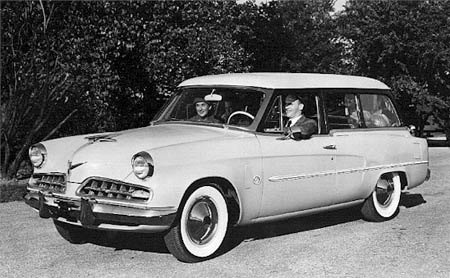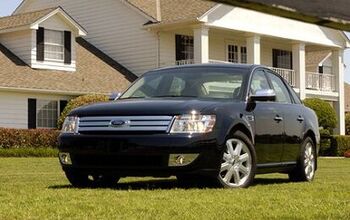Ford: Studebaker Redux?
In the summer of 2003, Ford celebrated their centennial. A hundred years in the car business is quite an achievement, considering the thousands of automobile companies that have come and gone since America started manufacturing cars. While analysts struggle to make sense of Ford's current financial problems, it's instructive to take a look at another automobile company, also started and run by a founding family, which also managed to last a hundred years. That company, of course, is Studebaker.
Fifty-two years ago, Studebaker celebrated their centennial. They were a solid number four in the automobile industry, leading second tier manufacturers like Nash and Packard by a decisive margin. The company enjoyed a reputation for design leadership, quality products and innovative engineering. Thanks to their early start in the transportation business, Studebaker dealers were thick on the ground. And of all the independent car companies, only Studebaker had a solid balance sheet. Surely this was a company with a bright future.
In 1953, Studebaker added another platform to cover their existing lineup of sedans, coupes and convertibles. The move doubled tooling, manufacturing, and investment costs. Studebaker's product and manufacturing engineers suddenly found themselves stretched to the breaking point, unable to successfully implement two new product lines at the same time. Quality suffered. In one disastrous year, Studebaker destroyed a reputation built up over decades.
Even worse, the models that the public wanted to buy, the sexy new 1953 coupes, simply could not be manufactured for many months. Studebaker lost almost six months production of the coupes, while their dowdy sedans languished on dealers' lots. This strategic blunder, coupled with the decision not to invest in the light truck product lines, initiated Studebaker's sudden decline as an automobile company.
By 1954, Studebaker had lost almost two thirds of their market share. The company was staring bankruptcy in the face. An American automobile manufacturer with a long history of overcoming obstacles in one of the toughest businesses in the world was in imminent danger of disappearing completely. Only the injection of new capital, in the form of a Packard takeover, kept the company alive.
The root cause of Studebaker's problems lay in the fact that its management lost interest in the company's core business: manufacturing cars and trucks. Instead of investing in new automotive products and technology, Studebaker used their ample financial resources to buy into companies outside the car business. They purchased steel mills, banks, insurance companies, furniture and appliance companies; even an airline (Trans International).
Ironically enough, the diversification saved Studebaker; they only survived as a company because they could afford to leave the car business entirely. In 1966, the companies Studebaker had acquired formed the basis of a new, instantly profitable holding company. Taking the name Studebaker-Worthington in 1967, the former carmaker prospered for many years after abandoning the business to their rivals.
The parallels between Studebaker's travails and Ford's current challenges are striking. Like Studebaker, Ford management has neglected their core business for many years. The Blue Oval is also using more platforms to cover the same market segments, especially compared to their main competitors. For example, Ford uses three platforms to cover the full-size pickup truck market segment, compared to a single one at Chevrolet or Chrysler.
Ford has also had many significant product failures, including the Lincoln Blackwood, Marauder, Thunderbird, Freestar and Monterey. Ford's dalliance with geriatric British nameplates has cost the company billions, with no end to the red ink in sight. In the last five years, Ford's poor product development has contributed to the loss of 45% of their passenger car market share and 20% of the light truck market share. In fact, Ford has lost market share every year for the last nine years.
Ford's core business cost them over $600 million in the last quarter. Yet the company still managed to post a profit of $260 million (or about $100 million, if you discount the earlier than expected income tax refund). Ford's bank, Ford Financial, and Ford Land, one of the largest land development companies in the US, provided the resulting profits. Think about how much money Ford could have made if they didn't bother to make cars at all…
Besides the fact that a founding family maintained ultimate control of both Ford and Studebaker, today's Blue Oval has something else in common with Studebaker: of all the US carmakers, only Ford can afford to leave the car business. Ford Financial and Ford Land, together with the $26 billion dollars they have in the bank, would form a very profitable company that would still rank in the Fortune 500.
Few commentators seriously believe that Ford will leave the car business. Yet, in 1952, no one thought the renowned Studebaker Company would be nothing more than a fond memory just a few years later.
More by Bob Elton
Latest Car Reviews
Read moreLatest Product Reviews
Read moreRecent Comments
- Dave M. My hipster daughter is greatly into it. We watched the race together this weekend. It was interesting but I'm not devoted to it like she is. She'll be at the Austin race in October.
- Bd2 If I had time to watch other people driving, then I would go for LMP.
- Steve Biro There are 24 races on this year’s F1 schedule. And I guarantee you no more than two will be reasonably exciting, Meanwhile, F1’s reception for Andretti reveals the dark underbelly of the sport. I have followed F1 since the 1960s and, frankly, I am running out of interest. I’ll catch a race if it’s convenient but won’t bother DVRing them.
- YellowDuck Been watching since the 80s, seriously since the 90s once we had reliable TV coverage. I'm in Canada though. Hey, and don't forget that the Interlagos race is also in a convenient time zone, as is Mexico. So that's 5 races in the Americas. Absolutely love it, but it takes a bit more interest in the technical / strategic side of things to really appreciate it. It's not just going fast in circles until someone crashes into someone else, while drunk people watch. The US can be proud of what it has contributed - Austin is one of the best tracks on the calendar, Vegas turned out to be much better than anyone could have hoped, and even Miami - a real Indy car-style track - produced a good race this year.
- JMII I watch every F1 race, same with Indycar which is 100X better in terms of actual racing.





































Comments
Join the conversation
I don't expect Ford to celebrate their 200th anniversary the way they are currently being run.